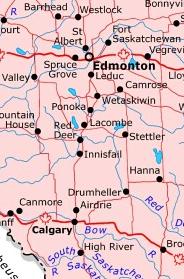当前你的浏览器版本过低,网站已在兼容模式下运行,兼容模式仅提供最小功能支持,网站样式可能显示不正常。
请尽快升级浏览器以体验网站在线编辑、在线运行等功能。
2854:Educational Journey
题目描述

The University of Calgary team qualified for the 28th ACM International Collegiate Programming Contest World Finals in Prague, Czech Republic. Just by using the initials of team members they got a very cunning team name: ACM (Alecs, Celly and Monny). In order to prepare for the contest, they have decided to travel to Edmonton to learn the tricks of trade from Dilbert, Alberta-wide famous top-coder.
Due to a horrible miscommunication which is as welcome as a plague among such teams, A, C and M drive from Calgary to Edmonton in separate cars. To make things worse, there was also a miscommunication with D, who being always so helpful, decides to go to Calgary in order to save the team a trip to the far, freezing North. All this happens on the same day and each car travels at a constant (but not necessarily the same) speed on the famous Alberta #2.
A passed C and M at time t1 and t2, respectively, and met D at time t3. D met C and M at times t4 and t5, respectively. The question is: at what time time did C pass M?
输入解释
The input is a sequence of lines, each containing times t1, t2, t3, t4 and t5, separated by white space. All times are distinct and given in increasing order. Each time is given in the hh:mm:ss format on the 24-hour clock. A line containing -1 terminates the input.
输出解释
For each line of input produce one line of output giving the time when C passed M in the same format as input, rounding the seconds in the standard way.
输入样例
10:00:00 11:00:00 12:00:00 13:00:00 14:00:00 10:20:00 10:58:00 14:32:00 14:59:00 16:00:00 10:20:00 12:58:00 14:32:00 14:59:00 16:00:00 08:00:00 09:00:00 10:00:00 12:00:00 14:00:00 -1
输出样例
12:00:00 11:16:54 13:37:32 10:40:00
最后修改于 2020-10-29T06:45:56+00:00 由爬虫自动更新
共提交 0 次
通过率 --%
| 时间上限 | 内存上限 |
| 1000 | 65536 |